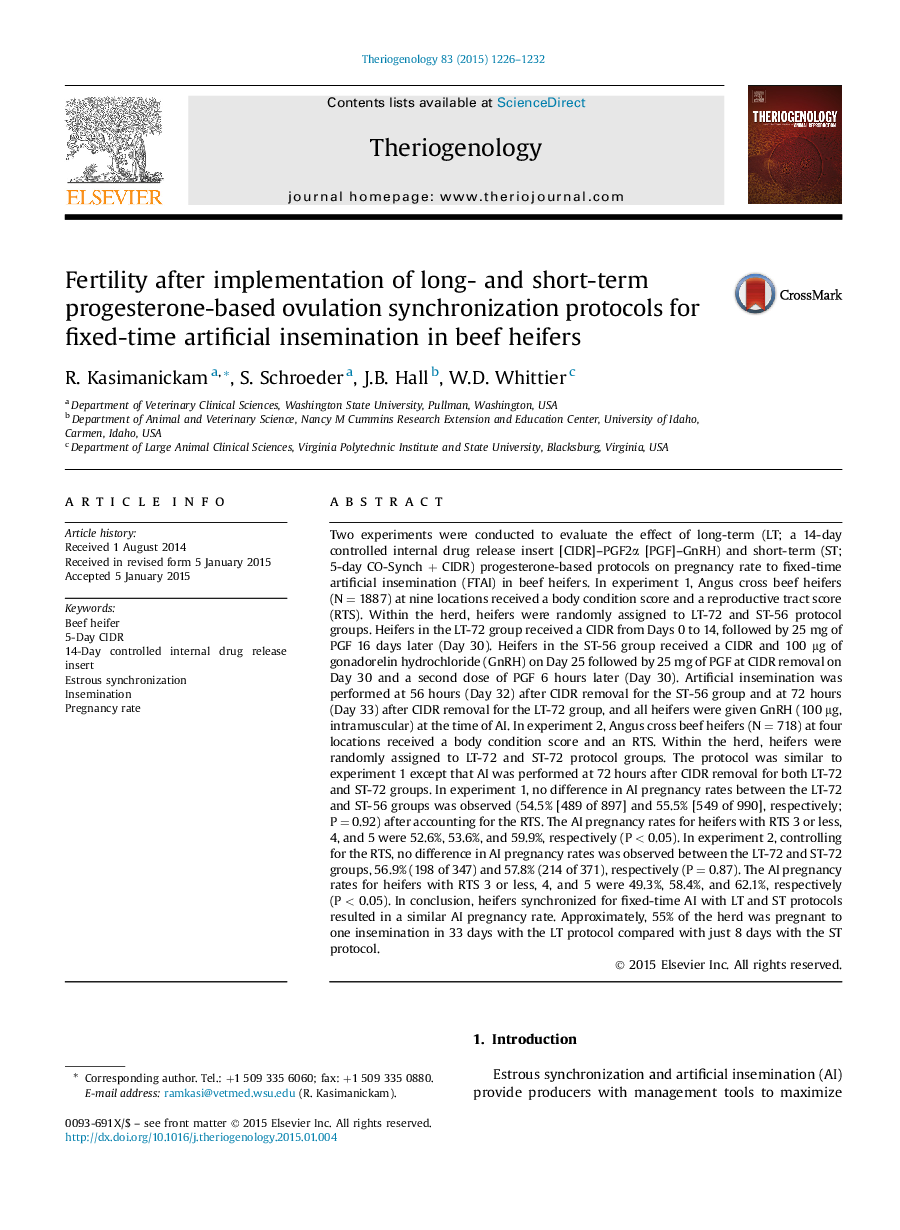| کد مقاله | کد نشریه | سال انتشار | مقاله انگلیسی | نسخه تمام متن |
|---|---|---|---|---|
| 2094996 | 1082064 | 2015 | 7 صفحه PDF | دانلود رایگان |
Two experiments were conducted to evaluate the effect of long-term (LT; a 14-day controlled internal drug release insert [CIDR]–PGF2α [PGF]–GnRH) and short-term (ST; 5-day CO-Synch + CIDR) progesterone-based protocols on pregnancy rate to fixed-time artificial insemination (FTAI) in beef heifers. In experiment 1, Angus cross beef heifers (N = 1887) at nine locations received a body condition score and a reproductive tract score (RTS). Within the herd, heifers were randomly assigned to LT-72 and ST-56 protocol groups. Heifers in the LT-72 group received a CIDR from Days 0 to 14, followed by 25 mg of PGF 16 days later (Day 30). Heifers in the ST-56 group received a CIDR and 100 μg of gonadorelin hydrochloride (GnRH) on Day 25 followed by 25 mg of PGF at CIDR removal on Day 30 and a second dose of PGF 6 hours later (Day 30). Artificial insemination was performed at 56 hours (Day 32) after CIDR removal for the ST-56 group and at 72 hours (Day 33) after CIDR removal for the LT-72 group, and all heifers were given GnRH (100 μg, intramuscular) at the time of AI. In experiment 2, Angus cross beef heifers (N = 718) at four locations received a body condition score and an RTS. Within the herd, heifers were randomly assigned to LT-72 and ST-72 protocol groups. The protocol was similar to experiment 1 except that AI was performed at 72 hours after CIDR removal for both LT-72 and ST-72 groups. In experiment 1, no difference in AI pregnancy rates between the LT-72 and ST-56 groups was observed (54.5% [489 of 897] and 55.5% [549 of 990], respectively; P = 0.92) after accounting for the RTS. The AI pregnancy rates for heifers with RTS 3 or less, 4, and 5 were 52.6%, 53.6%, and 59.9%, respectively (P < 0.05). In experiment 2, controlling for the RTS, no difference in AI pregnancy rates was observed between the LT-72 and ST-72 groups, 56.9% (198 of 347) and 57.8% (214 of 371), respectively (P = 0.87). The AI pregnancy rates for heifers with RTS 3 or less, 4, and 5 were 49.3%, 58.4%, and 62.1%, respectively (P < 0.05). In conclusion, heifers synchronized for fixed-time AI with LT and ST protocols resulted in a similar AI pregnancy rate. Approximately, 55% of the herd was pregnant to one insemination in 33 days with the LT protocol compared with just 8 days with the ST protocol.
Journal: Theriogenology - Volume 83, Issue 7, 15 April 2015, Pages 1226–1232
